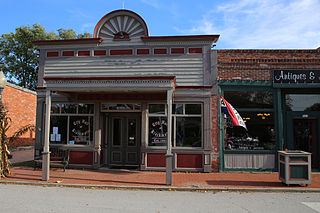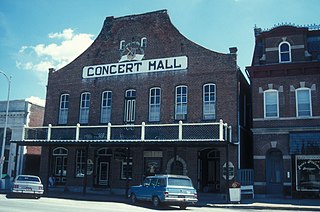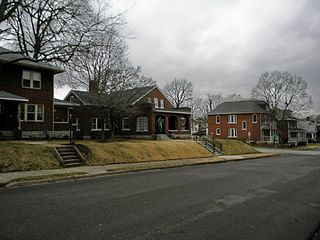
Blackwater is a city in northwest Cooper County, Missouri, United States located along the Blackwater River, from which it takes its name. The population was 162 at the 2010 census.

The Distillery District is a commercial and residential district in Toronto, Ontario, Canada, east of downtown, which contains numerous cafés, restaurants, and shops housed within heritage buildings of the former Gooderham and Worts Distillery. The 13 acres (5.3 ha) district comprises more than forty heritage buildings and ten streets, and is the largest collection of Victorian-era industrial architecture in North America.

Hyde Park is a neighborhood and historic district in Austin, Texas. Located in Central Austin, Hyde Park is defined by 38th Street to the south, 45th Street to the north, Duval Street to the east, and Guadalupe Street to the west. It is situated just north of the University of Texas and borders the neighborhoods of Hancock and North Loop.

Anheuser-Busch Brewery is a brewery complex in St. Louis, Missouri. It was opened in 1852 by German immigrant Adolphus Busch. It a National Historic Landmark District. The Lyon Schoolhouse Museum is on the grounds at the Anheuser-Busch Brewery. It is considered to be one of oldest school buildings in St Louis. It served as the head offices of the brewery after 1907. The museum contains rare mementos gathered from the founding of the company to current day, including pictures of the brewery and its expansion over the years. The 142 acres (57 ha) property includes 189 buildings. Some of the most striking are red brick Romanesque architecture with crenelated towers and elaborate ornamentation.

Clarksville Historic District is a national historic district located at Clarksville, Pike County, Missouri. The district encompasses 65 contributing buildings in the central business district and surrounding residential sections of Clarksville. It developed between about 1840 and 1930, and includes representative examples of Greek Revival, Italianate, and Queen Anne style architecture. Located in the district is the separately listed Clifford-Wyrick House. Other notable buildings include the City Hall (1910), Sentinel Building (1867-1871), Clifford Banking Company, La Crosse Lumber Company (1923), Presbyterian Church, Methodist Church (1906), Masonic Temple (1903), and Clarksville Public Library (1910).

Hermann Historic District is a national historic district located at Hermann, Gasconade County, Missouri. The district encompasses 360 contributing buildings, 4 contributing structures, and 3 contributing objects in the central business district and surrounding residential sections of Hermann. The district developed between about 1838 and 1910, and includes representative examples of Greek Revival and Classical Revival style architecture. Notable buildings include the Eitzen House (1855), Potnmer-Gentner House (1848), Hermann City Hall (1906), Strehly House (1845), Concert Hall (1877), The German School (1871), and Gasconade County Courthouse (1896).

Sutton Downtown Historic District is a national historic district located at Sutton, Braxton County, West Virginia. It encompasses 85 contributing buildings and two contributing structures covering eleven square blocks. The district includes the commercial, ecclesiastical, and civic core of the town and surrounding residential area. The district includes a number of buildings representative of popular architectural styles from the late-19th century and early-20th century including Romanesque Revival, Colonial Revival, Gothic Revival, and Greek Revival. Notable buildings include the Braxton County Courthouse (1881-1882) and Jail (1905), Sutton Bank Building (1891), Farmers Bank and Trust (1909), Bank of Sutton, Methodist Episcopal Church, South (1896), Kelly / Fisher House. Elk / Midway Hotel (1894), and Katie B. Frame Residence. The two structures are the Bridge over Old Woman Run (1892) and Bridge over Elk (1930).

The Lansdowne Park Historic District is a national historic district that is located in Lansdowne, Delaware County, Pennsylvania, USA.

Pee Dee Avenue Historic District is a national historic district located at Albemarle, Stanly County, North Carolina. The district encompasses 87 contributing buildings and 1 contributing site in a predominantly residential section of Albemarle. They were built between about 1891 and 1947 and include notable examples of Queen Anne, Colonial Revival, and Bungalow / American Craftsman style residential architecture. Notable buildings include the Brown-Parker House, Crowell House, Lambert-Hughes-Ferrell House, W. Berly Beaver House (1929-1936), David Augustus Holbrook House (1929-1936), Langley-Holbrook House, William Thomas Huckabee, Jr., House (1947), Robert Lee Smith Family House, and Wade F. Denning House.

Columbus Historic District is a national historic district located at Columbus, Bartholomew County, Indiana, United States. It encompasses 574 contributing buildings and 1 contributing sites in the central business district and surrounding residential areas of Columbus. It was developed between about 1850 and 1930, and includes notable examples of Federal and Italianate style architecture. A number of commercial buildings feature locally manufactured cast iron and pressed metal components. Located in the district are the separately listed Bartholomew County Courthouse, Columbus City Hall, and First Christian Church. Other notable buildings include the First National Bank, The Crump Theatre (1889), Reo Theater, Ulrich Bakery, Samuel Harris House (1853), Keller House (1860), Old Post Office (1910), Franklin Building, Gent Mill, First United Presbyterian Church (1871-1885), Irwin Block, Irwin Home and Gardens, and St. Batholomew's Roman Catholic Church (1891).

Plainfield Historic District is a national historic district located at Plainfield, Hendricks County, Indiana. The district encompasses 174 contributing buildings in the central business district and surrounding residential area of Plainfield. The district developed between about 1840 and 1959 and includes notable examples of Greek Revival, Gothic Revival, Italianate, Queen Anne, and Bungalow / American Craftsman style architecture. Notable buildings include the Ezra Cox House, Oscar Hadley House (1891), Plainfield Carnegie Library (1912), Plainfield Methodist Episcopal Church (1891), Bly Bros. Dry Goods Store, Knights of Pythias Building, Prewitt Theater (1927), First National Bank of Plainfield (1903), Mansion House Hotel (1874), Fisher's Tavern, and Quaker Meeting House (1857-1858).

Court Street Historic Residential District is a national historic district located at Fulton, Callaway County, Missouri. It encompasses 84 contributing buildings in a predominantly residential section of Fulton. It developed between about 1844 and 1945, and includes representative examples of Queen Anne, Second Empire, Colonial Revival, American Foursquare, and Bungalow style architecture. Some of the buildings were designed by noted local architect Morris Frederick Bell. Located in the district is the separately listed Brandon-Bell-Collier House. Other notable buildings include the John W. Tucker Residence (1912), Klinginsmith Residence, Synodical College-Seminole Apartments, Synodical College Dormitory-Seminole Apartments (1913), Gish Residence, Dave and Ida McCue House, First Presbyterian Church, Leland Waters Residence, Bauer House, and Martin-Harris House.

Harrisonville Courthouse Square Historic District is a national historic district located at Harrisonville, Cass County, Missouri. The district includes 34 contributing buildings, 1 contributing structure, and 1 contributing object in the central business district of Harrisonville. It developed between about 1880 and 1943, and includes representative examples of Italianate, Queen Anne, Colonial Revival, Tudor Revival, and Renaissance Revival style architecture. Notable buildings include the Cass County Courthouse (1897), New Method Laundry (1929), Cass County Democrat, Wooldridge Building, Bank of Harrisonville (1900-1901), Wirt's Opera House Building, Post Office Building (1925), Emmons Building/Bowman Building (1887), Evans Building (1890), White Motor Company, Stephen Stuart "Racket" Store, First National Bank of Harrisonville, and Deacon Building (1892).

Capitol Avenue Historic District is a national historic district located at Jefferson City, Cole County, Missouri. It encompasses 107 contributing buildings in a predominantly residential section of Jefferson City. The district developed between about 1870 and 1947, and includes representative examples of Classical Revival, Late Victorian, Bungalow / American Craftsman, and Art Deco style architecture. Located in the district are the separately listed Lester S. and Missouri "Zue" Gordon Parker House, Jefferson Female Seminary, Missouri State Penitentiary Warden's House, and Ivy Terrace. Other notable buildings include the Parsons House (1830), former Missouri Baptist Building (1947), Grace Episcopal Church (1898), Elizabeth Alien Ewing House (1873), James A. Houchin House, J. Henry Asel, Sr. and Hilda Asel House (1898), Dix Apartments (1915), W.C. Young House, Bella Vista Apartments (1928), and Prince Edward Apartments (1930).

Blackwater Commercial Historic District is a national historic district located at Blackwater, Cooper County, Missouri. The district encompasses 12 contributing buildings in the central business district of Blackwater. It developed between about 1889 and 1950, and includes representative examples of Late Victorian style architecture. Notable buildings include the Frady Hotel, Adam Schuster Building, Lee O'Neal Hardware Store, and L. F. Berry, John Smith and Lizzie Fisher Building.

New Haven Residential Historic District is a national historic district located at New Haven, Franklin County, Missouri. The district encompasses 26 contributing buildings a predominantly residential section of New Haven. The district developed between about 1857 and 1945, and includes representative examples of Italianate, Queen Anne, Colonial Revival, and Bungalow / American Craftsman style architecture. Notable buildings include the Langenberg Hat Factory, William H. Otto Furniture Store, Central Hotel, Dr. John S. Leewright House (1857), Lillie Patton House, Richard Schure House, George Wolff Sr. House (1880), Edward Hebbeler House (1916), and Emil Wolff House.

Locust Street Historic District is a national historic district located at Washington, Franklin County, Missouri. The district encompasses 123 contributing buildings in a predominantly residential section of Washington. The district developed between about 1839 and 1949, and includes representative examples of Italianate, Queen Anne, Colonial Revival, and Bungalow / American Craftsman style residential architecture. Located in the district is the separately listed Franz Schwarzer House. Other notable buildings include the Lucinda Owens House (1839), Frederich Griese House, Sophia Greiwe House, Presbyterian Church (1916), Hy. Oberhaus House, Gustav Richert Apartment Building, Southern Presbyterian Church/Attucks School (1868), Washington High School (1887), and AME Church

Stafford–Olive Historic District is a national historic district located at Washington, Franklin County, Missouri. The district encompasses 140 contributing buildings in a predominantly residential section of Washington. The district developed between about 1858 and 1949, and includes representative examples of Queen Anne, Second Empire, Tudor Revival, Colonial Revival, and Bungalow / American Craftsman style residential architecture. Notable buildings include the Jos. Rumme House, Chas Haupt House, Louis Horn House, F. R. Pelster House, Hydecker House, Stephen Filla House, Chas. Kopp House, Hy. Thias Honse, and William Pace House (1929).
Fayette Residential Historic District is a national historic district located at Fayette, Howard County, Missouri. The district encompasses 308 contributing buildings and 2 contributing structures in a predominantly residential section of Fayette. It developed between about 1832 and 1956 and includes representative examples of Gothic Revival, Italianate, and Queen Anne style architecture. Located in the district is the separately listed Coleman Hall. Other notable buildings include the Hampton L. Boon House / George Carson House, W. W. Blakemore House, John Sears House / John B. Clark House, McKinney Sisters House, Tully Chenowith House, Methodist Episcopal Parsonage, T. A. F. Mitchell House, Oliver H. P. Corprew House (1880s), Huntington Hall, A. F. Davis House (1880-1884), R. Lee Maupin House (1905), Mrs. John H. Farrington House, the Daly School (1924), the T. A. Grigsby Building, and St. Joseph's Catholic Church (1956).

Edina Double Square Historic District is a national historic district located at Edina, Knox County, Missouri. The district encompasses 37 contributing buildings in the central business district of Edina. It developed between about 1865 and 1945 and includes representative examples of Italianate and Streamline Moderne style architecture. Notable contributing buildings include the Public Works Administration funded Knox County Courthouse (1934–1935) designed by William B. Ittner, Bishoff Bakery (1891), Northern Hotel (1860s), Ennis House/Northern Hotel, Edina School and Gymnasium (1915–1916), D. H. Mudd Building, Phillip Linville Building, Tobias J. Lycan Building, Jacob Pugh Building, Albert G. Bostick Building, Knox County Savings Bank, Thomas Burk Buildings, Bank of Edina Building, Joseph F. Biggerstaff Buildings, Stablein Building, and Knox County Public Library.























